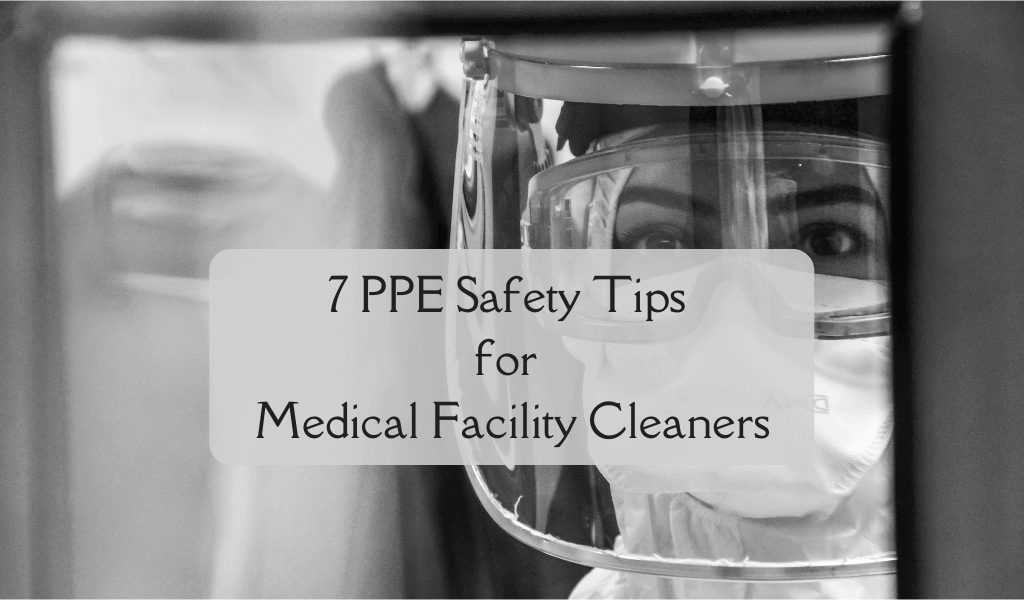PPE safety tips and reminders are always important, but especially for long-term care and medical facility cleaners.
Even in the best of times, PPE safety tips are essential aspects of janitorial training. Whether you’re dealing with concentrated cleaning products, moldy workplace conditions, or questionable grime, PPE can help you and your janitorial team remain safe.
Some environments present additional hazards, particularly medical facilities. For example, hospitals, walk-in clinics, outpatient centers, and long-term care facilities all present an increased risk of working with bodily fluids, harsh cleaning chemicals, and potentially contaminated surfaces.
And yet, over time, it’s easy to let things slip. We may cut corners on wearing the right PPE for more minor issues or just get in a hurry and skip tightening a strap here or there. As with so many other safety issues, PPE safety tips are always good to review – or learn for the first time, as the case may be.
If you are ready to bring your cleaning organization to the next level, take advantage of a free call with Janitorial Manager to see how our software can make you a more successful janitorial operation.
Discover 7 PPE safety tips you can’t ignore
Spoiler alert: You can’t discuss PPE safety tips today without mentioning Covid. As we all know, when this coronavirus hit us in 2020, PPE shortages were big news. There simply wasn’t enough to go around. As a result, people working in medical facilities struggled to stay safe amid a new and unknown virus, often without the proper PPE.
Luckily, and thanks to a lot of hard work from a variety of industries and people, that’s not the problem it was. However, the combination of a contagious airborne virus and a shortage of PPE made it clear how vital this equipment is for medical facility cleaners. Hence, the first of the PPE safety tips:
1. Keep a steady supply of PPE. Managers and business owners need to have a readily available supply of proper PPE for employees. What that is precisely will change depending on the facility and the most up-to-date scientific findings, but at a minimum, you’ll need gloves, eye protection, and either surgical masks, N95 masks, or KN94 masks.
2. Assess hazards. It’s important to know what kind of protection you may need. Because of Covid, face masks are almost always required. But there are other hazards and levels of risk that you need to account for. Eye protection will help prevent splash injuries if you mix or dilute cleaning products. However, you may not need the same coverage for vacuuming.
3. Use the right PPE. Even though gloves and masks are a minimum, you may need further protection. For example, biohazard clean-up often requires full-body protection, including shoe covers and protective garments. It’s also worth noting that the “right” PPE is relative to the environment.
4. Train your team on proper usage. The Centers for Disease Control and Prevention (CDC) has a series of short videos for both putting on (donning) and removing (doffing) PPE. These won’t take much time to review, and they help ensure that everyone on your team understands the importance of wearing PPE properly.
5. Remember that PPE isn’t your only line of defense. This is one of the PPE safety tips that’s easy to forget. To be clear, this isn’t a statement against PPE. We know it works when used correctly. However, there’s a lot you can do to keep yourself and your team safe that should come before a reliance on what protective gear you’re wearing. For example, handle cleaning chemicals carefully, and you won’t need to worry about chemical spills.
6. Take outdoor breaks. Wearing PPE for hours gets exhausting. If possible, build breaks into the schedule so everyone can get outside and enjoy some fresh air. Even a few minutes can do wonders to refresh and rejuvenate a tired team.
7. Review facility protocols. Each medical facility may have different needs and requirements for PPE. Therefore, your PPE safety tips and instructions may change according to the location. A hospital probably requires more PPE than, say, a walk-in clinic.
Remember, too, that safety isn’t just about PPE safety tips. There are still a number of steps you and your team can take to remain safe. Paying attention to personal safety and watching out for teammates can keep everyone safe. In addition, keeping your awareness around slip and fall hazards can help prevent injuries.
And if you want to take the next step, basic CPR and first aid training, as well as emergency preparedness training, could come in handy on any job, whether that’s at a medical facility or your run-of-the-mill office cleaning job.
When it comes to safety, you can never know too much. And that’s good for everyone involved.
Increase efficiency, reduce costs, and improve results. With Janitorial Manager, all this and more isn’t just a dream, it’s your new reality. Contact us for a free consultation right now and see how it works!


